The use of stamps for telegrams.
- Australia 1901-1988
- New South Wales
- Queensland
- South Australia
- Tasmania
- Victoria
- Western Australia
- International
- Special aspects
None of the three Tasmanian transmission formats provided a space to "affix postage stamps" until the Interim period. There is therefore an uncertainty about when postage stamps may have been used for prepayment of telegram costs.
Tasmania might have followed the lead of New South Wales (1885 or 1893) and of Victoria (1876) and used stamps on telegram transmission forms. After the amalgamation of the Post and Telegraph Departments in 1894, receipts for telegrams had stamps affixed to the butt which were then cancelled. There was a box on the butt containing the words "Penny stamp to be affixed and cancelled with Office Date Stamp". The earliest recorded butt is on 15 November 1902 at Zeehan (see Clemente, p. 40).
Some people consider the use of stamps on telegram transmission forms did not happen until 1896. Evidence to support this view is the statement in the 1896 Report on the PMG Department which states that "the usage of stamps increased considerably because stamps were to be used on telegrams henceforth". On balance, it can be assumed that the use of stamps to prepay telegram charges was introduced to Tasmania on 1 January 1896.
The public were apprehensive and needed reassurance. The Launceston Examiner provided the following comment to one of its anxious readers:
TELEGRAPHY. TO THE EDITOR. Sir,
I notice that the Tasmanian Telegraph Department intend introducing the system now in vogue in Victoria, viz., stamping. Kindly state advantages; the disadvantages are many.-Yours, etc., TELEGRAM.
ED: The chief advantage claimed by the department for the system of payment of telegrams by means of postage stamps is that it gives the maximum of check with a minimum of trouble. It is not anticipated that it will make the slightest difference to the public, because in this colony it is not insisted on, as in some of the colonies, that the public should place the stamps upon the messages. This may be done by officers of the department, the observation and check to which every message will be subjected in the account branch at chief office being considered ample to detect any fraud. The lines will be relieved of all checking business by this system. The messages will be concentrated at chief office instead of being retained at each office as at present.
The nature of stamps to be used on telegrams in Tasmania is noted in the Wellington Times, the Agricultural Gazette (and other newspapers) of 14 January 1896 by citing the Waratah Inquirer:
Payment for Telegrams: Under the regulation now in force for stamps to be affixed in payment for telegrams, the smallest possible number of stamps should be used. That is to say, if a telegram costs 1/-, a 1/0 stamp should be used and not a number of stamps of smaller value. There is nothing to prevent the sender handing in a telegram with the stamps of proper value affixed, and the telegram cannot be objected to on that account.
As transmission forms, to which postage stamps would be affixed, all had to be destroyed - and (unfortunately) they were - there is no evidence known which can give a conclusive insight into the actual situation.
Postage stamps which were on issue in the early 1890s and after and which could therefore have been used to pay telegram charges are:
| 9d. make-up rates | 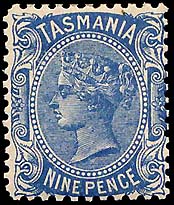 9d blue to indigo. 1903 Sideface. |
||
| 1/- ordinary rate. 12 words or less. |
|||
| 1/- rose and green key plate. 1892 (SG 221) to 1907 (SG 257). |
|||
| 2/6 make-up rate. | 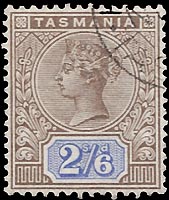 |
||
| 2/6 brown & blue key plate. 1892 printing (SG 222). NOTE: Tasmania never issued a |
|
||
| 5/- make-up rate for high-value telegrams. |
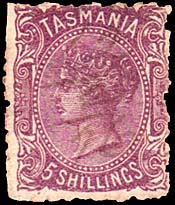 5/- purple side face. 1871 printing but on issue until 1897. (SG155). May have been used on some early telegrams. |
5/- lilac & red key plate. 1897 printing (SG 223). |
|
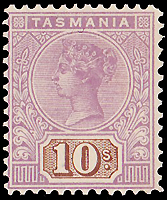 |
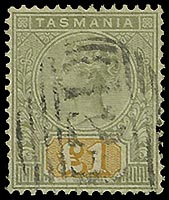 |
||
10/- mauve & brown key plate. Status Auctions |
£1 green & yellow key plate. 1897 printing (SG 225). |
Postal Fiscal stamps
There are also some postal fiscal stamps which may have been used to pre-pay telegraph changes.
Postal fiscal stamps and postage stamps became interchangeable from 1 November 1882. This situation continued until 30 June 1901 after a slight confusion in November 1900 relating to overprinted REVENUE stamps.
The design most likely to have been used to pre-pay telegraph charges was the St. George & Dragon. The design had actually been issued from November 1863 (2/6) and January 1864 (5/- and 10/-) printed on watermark 1 paper. Clearly these stamps are too early to be considered for telegrams. A 3d green in the same design was also printed but is less likely to have been used for telegrams.
The printings which may have produced this design for use on telegrams are:
- in 1880, the three denominations (imperforate or with any of four perforations) were reprinted in different shades
on the watermark 1 paper (2/6 in lake, 5/- in sage-green and 10/- in salmon); - in August 1888, a reprint of the 2/6 lake (perf 12) on paper with a watermark TAS (letters close together) paper;
- in 1889, the 10/- again printed on numeral 1 watermark paper in a reddish-salmon shade.
If usage was authorised in 1896, it is unlikely that many, if any, of the 5/- denomination would have been used on telegrams as the stock was almost gone by 1896.
In November 1900, the 2/6 and 10/- denominations were overprinted REVENUE but, as noted, these were soon invalidated for postage purposes.
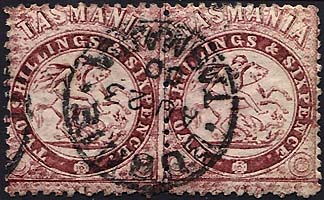 |
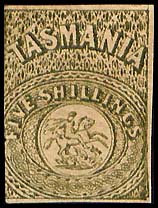 |
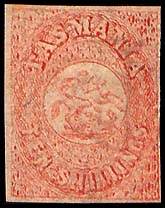 |
|
| 3d green. | 2/6 lake. Used at Burnie 23 August 1900 - 5/- would have been a higher value but not an unusual charge for a telegram. Tasmanian Stamp Auctions, February 2013. |
5/- sage-green. Millenium Auctions 2012 |
10/- salmon Millenium Auctions 2012 |